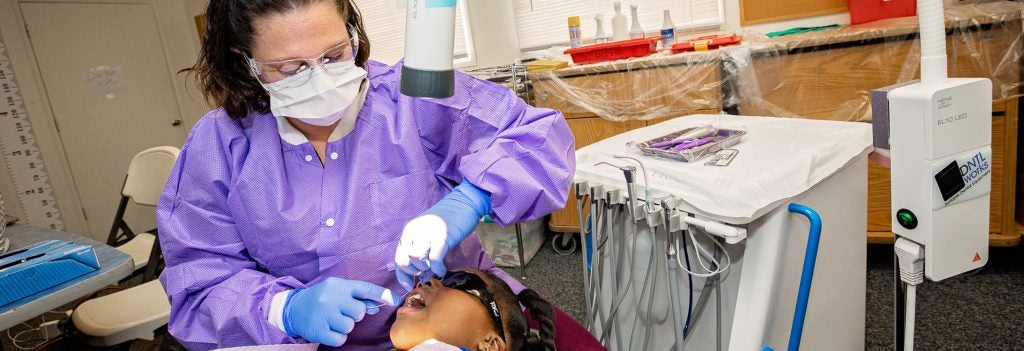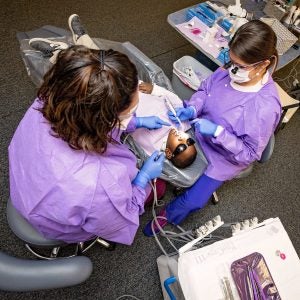HEALTHIER SMILES IN BERTIE COUNTY: ECU dental school brings school-based oral prevention program through Duke Endowment
Fannie Williams knows what it’s like to grow up in an area where dentists are scarce.
Williams grew up in Bertie County, North Carolina, where she now serves as interim principal of Windsor Elementary School in the town of Windsor. She knows first-hand how hard it can be for Bertie County families to visit the dentist. Seeing children with tooth decay, tooth loss and tooth pain is part of the daily routine for teachers and school nurse, Ms. Georgetta Smallwood.

The Bertie County School Based Oral Prevention Program will offer dental services to all public elementary and middle school students in Bertie County over the next two years. (Photos by Cliff Hollis | Video by Bryan Edge)
“I believe we only have one dentist in the county, and many families don’t have the transportation to get to a dentist,” said Williams.
In fact, Bertie County, located in the state’s northeast quadrant, has only one or two licensed dentists for a population of over 21,000 people.
Now, a $400,000 grant from the Duke Endowment is making it possible for the East Carolina University School of Dental Medicine to go a step further in delivering oral health care to children in Bertie County through the Bertie County School Based Oral Prevention Program.
According to the 2015-2016 Kindergarten Oral Health Status Report by the North Carolina Department of Health and Human Services Oral Health Section, 19% of the kindergartners screened in Bertie County had untreated tooth decay. The same study found that 15% of kindergarteners screened state-wide had untreated tooth decay.
Counties with demographics like Bertie’s are the reason the ECU dental school was created and why it has opened eight community service learning centers in rural and underserved areas of North Carolina–where faculty, students, residents, and staff treat patients every weekday.
The program, which is already underway at Windsor Elementary School, will offer comprehensive dental exams, x-rays, cleanings, fluoride varnish application, and dental sealants to all public elementary and middle school children in Bertie County over the next two years.
An ECU dental team will care for the children on site at each school. Of the 385 students at Windsor Elementary School, 137 students have been enrolled in the program by their parents. The team works with the children in an annex set up at the school like a dental office.

Dental hygienists Jennifer Buck (left) and Rachel Stewart provide cleanings, fluoride treatments and/or dental sealants as recommended for each child by a faculty dentist.
“Dental disease is 100% preventable when consistent measures are taken to ensure that children have access to oral health care,” said Dr. Wanda Wright, the dental school’s division director of dental public health. Wright is author of the grant proposal and director of the program.
“We know that programs based in schools are effective but have not been widely replicated in our region,” Wright said. “Bringing these programs to Bertie County will provide students with needed dental care in safe, convenient, and accessible locations.”
Dr. Ford Grant, faculty director of the dental school’s community service learning center in Ahoskie, drives 30 miles to Windsor several times each month to give each child in the program an oral exam.
Dental hygienists Rachel Stewart and Jennifer Buck, the program’s case managers, provide oral health instruction in every classroom and have created bulletin boards in the school’s hallway to remind the children to brush their teeth.
Stewart and Buck take x-rays, and provide cleanings, fluoride treatments and/or dental sealants as recommended for each child by Grant. They send reports to the parents after treatment, and if restorative dentistry is indicated, they help parents coordinate a visit to their child’s dentist or to the dental school’s community service learning center in Ahoskie.
Every child who participates in the program will be seen twice a year by a faculty dentist and dental hygienists.
The program intends to become self-sustaining after the two years of grant funding through patient reimbursement fees from Medicaid and/or private dental insurance companies. Resources from grant funding, in combination with existing resources from the dental school, will work to ensure the long-term sustainability of the project and provide a comprehensive oral health program for low-income children in Bertie County.

Dental hygienists Jennifer Buck and Rachel Stewart presented oral health instructions for every child at Windsor Elementary School and created bulletin boards reminding children to brush.
Wright hopes that in time a program such as this can be extended to other counties in the northeastern part of the state with similar demographics.
“One reason that I’m so positive about this program is that along with preventive applications, we can actually offer families a dental home at the school’s center in Ahoskie,” she said.
The ECU School of Dental Medicine accepts Medicaid and most private insurances, and works with uninsured patients. About 88% of the children in the program at Windsor Elementary School are Medicaid recipients, about 2% carry private insurance and about 9% are uninsured.
“We have seen oral health programs come and go at our schools,” said Williams, “but we think this program has a very good chance of success. To see so many children enrolled in a program of this type is unusual. I think the fact that it’s an ECU program has a lot to do with the numbers.
PUBLISHED JAN 31, 2020 BY
FILED UNDER: